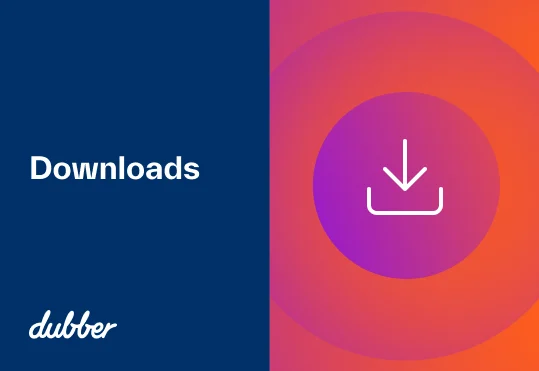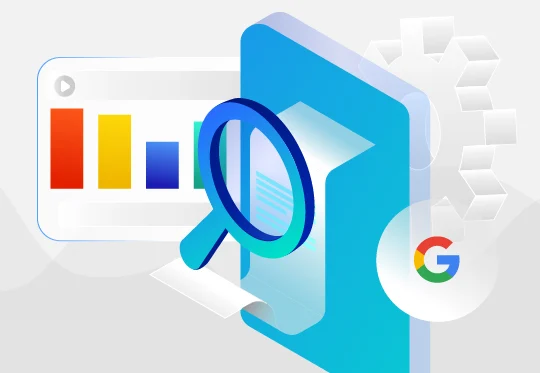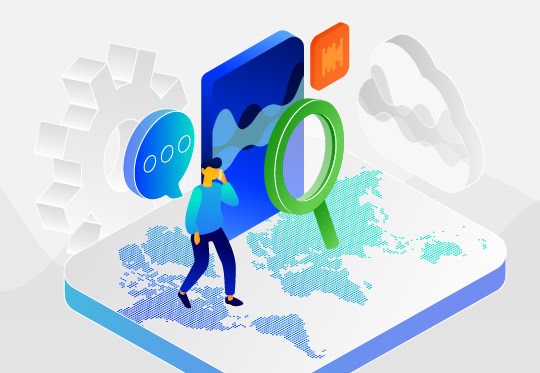
How well do you listen to your customers? Turns out, they could be telling you more than you think. Dubber AI has the potential to tell you exactly what your customers think about your brand and products, and even guide you to deliver what they want.
Every conversation with a customer is packed with vital information: a mention of a competitor’s name can be a prompt for the retention team, angry words can indicate product or customer service issues and might lose you repeat business, but a phone call full of kind words and thanks can show you that a member of your contact centre team deserves a reward.
Stand out from the competition
Customer service is the top differentiator between brands and the more you know about your customer, the more you can understand how to improve their experience. With Dubber AI, customer calls are transcribed using speech to text engines. These transcriptions can be stored against the customer within a CRM, when integrated with our API. This valuable data opens up huge potential to learn more about your customers. Customer service teams would have access to information from previous calls at their fingertips, allowing them to help with enquiries more quickly and easily.
Personalisation is becoming part of customer expectations as services such as Netflix offer tailored recommendations to users and Spotify creates playlists based on user listening behaviour. In the past it might have been difficult for other businesses to offer such a personalised approach due to limited data but, with the introduction of voice AI, that’s no longer the case. With call transcripts integrated into CRM systems, this allows businesses to create detailed customer profiles, enabling them to provide hyper-personalised customer interactions. This means a customer can call a large customer service centre and be directed to the agent that they have spoken to previously.
Proactive customer service
AI helps in the day-to-day running of a customer service team. Information from sentiment analysis can help managers understand trends about complaints, and train their staff to deal with common issues more efficiently. The possibilities for the future of AI are limitless: from automatic call routing to the best agent based on historical call transcripts, to proactive calming measures for customers who have consistent negative sentiment in their previous interactions.
Accessibility
Dubber AI doesn’t require in-house data scientists or machine learning experts. With our platform directly connected to carriers, introducing AI to a business has never been easier.
To find out more about how Dubber AI can improve customer service, talk to a member of our team today.

Telstra and Dubber Sign Agreement for cloud call recording and AI on Business Telephony and mobile services

Can you tell the difference between an Australian saying ‘a boat’, an American saying ‘a bat’, someone from the UK saying ‘a boot’ and a Canadian saying ‘about’? Google can.
Here at Dubber, we have a team dedicated to expanding our AI capabilities. We know that in today’s global economy, where businesses operate from locations around the world, English speakers don’t all speak like the Queen of England (no matter how many episodes of The Crown we watch). We want to ensure that our voice AI can support businesses in their global operations, with transcription that covers not just variants of English but other languages spoken by millions around the world.
That’s why we added Google’s Speech-to-Text machine learning product to our suite of transcription engines, so that we can deliver the best transcription capabilities across the broadest set of languages and accents.
Transcription with unparalleled accuracy
Adding Google’s transcription means we can now support a wider range of languages, including Dutch, French, Spanish, German, Mandarin, Portuguese, and six regional variants of English. This will allow us to serve more of the world with our cloud call recording and voice AI. Google Speech-to-Text applies powerful neural network models to transcribe audio from a variety of sources with high levels of accuracy. These deep-learning algorithms are under constant improvement, with ever-increasing accuracy.
Google Speech-to-Text is now available on Dubber as a premium AI engine. Want to learn more about how you can access the benefits of transcription powered by Google? Talk to our team today.

In a world that is increasingly reliant on a workforce that can work anytime, anywhere, businesses are looking for increased connectivity through innovations in wired and wireless solutions. Enter fixed-mobile convergence (FMC), where calls can be seamlessly transferred from fixed to mobile devices and vice versa. Read an in-depth guide to FMC in our white paper.
Although FMC is by no means new, the infrastructure and investment required means it has been slow to realise. But with advancing technology, the idea of combining offerings into one bundle for customers is beginning to gain traction. Could 2020 see developments in converged offerings?
What does FMC mean for businesses?
The growing popularity of FMC is the result of both customer needs and networks looking to stay ahead of the competition and retain customers with more powerful, personalised services.
FMC solutions create a union between wired and wireless technologies and allow calls to continue without dropping even as the user moves from location to location and between devices. FMC also enables better reachability, so that customer-facing employees can be reached on the first try — whether they are in the office or out on the road. Similarly, single-number reach allows customers and clients to contact a business on one number that redirects calls to available contacts, through cloud-based communications technology.
Enterprises that deploy solutions that unify fixed and mobile communications will see increased productivity.
What does FMC mean for telecommunications service providers?
Telecommunications service providers have already begun to buy into the concept and are benefitting from being early adopters of the technology. By bundling their fixed and mobile services, service providers are likely to reduce customer churn as they are able to offer cheaper packages, while increasing average revenue per user.
These simplified communication solutions also make it easy for providers to offer value-added services like cloud-based call recording from one single, unified portal without requiring any up-front investment, hardware or lengthy setup processes.
By moving to the cloud, telecommunications service providers can combine wired and wireless communications in one solution, offering greater flexibility, ease of use, and reduced IT and network costs for providers and their users.
Get in touch to find out more about how Dubber call recording and voice AI can work with FMC solutions.

The fifth, and final, instalment of our Fourth Industrial Revolution series explores what telecommunication service providers need to do in order to provide for the new digital workforce. Part one of the series gave an overview of the Fourth Industrial Revolution, part two looked at intuitive networks and how 5G and cloud technology fit into developments in the telecommunications industry, part three examined the growing importance of diversity in telecommunications product offerings, and part four examined the evolving expectations of customers.
The digital workforce is a manifestation of automated solutions, in various stages of development, that are currently driving productivity in the workforce. Integrations that share data across business tools are making workers and business processes more efficient, allowing employees to focus on more valuable activities. Over the next few years, enterprises will be increasingly deploying efficiency solutions driven by automation in order to improve the quality and productivity of their operational, back office, and customer service processes. Telecommunication service providers need to ensure they are meeting the expectations of modern businesses with their offerings, or they may be faced with increased risk of customer churn.
The connected workforce
Connectivity is steadily increasing due to innovation within the telecommunications industry, such as fixed-mobile convergence (FMC). You can read more about FMC in our white paper. However, digital players are making their way into the marketplace and disrupting the industry with rapid digital innovation. These agile disruptors are unpredictable and aren’t restricted by the legacy infrastructure and long development cycles that can hold traditional telecommunication service providers back from innovation. Digital services can often offer more opportunities for integration with existing systems, as well as better connectivity. Telecommunications service providers will need to innovate to compete with these digital players.
Alternative innovation
Innovation in the telecommunication industry has traditionally been characterised by staged developments that span multiple years. In order to compete with digital players and develop new products and services that can be deployed at scale, providers will need to review their innovation strategies. The World Economic Forum has discussed a recent trend towards innovation approaches that focus on collaboration, and the positive impact on growth that this achieves. Gone are the days of focusing on the ownership rights to intellectual property: the main focus in the future should be putting customers first. This is vital to obtaining a share of the market. These kinds of open innovation models allow external parties to contribute to the development of products and services, often achieving development at a scale that goes beyond the sum of its parts. Telecommunications companies have successfully nurtured a “sandbox” innovation approach that allows their research and development teams to work autonomously: giving them greater freedom for innovation.
Harnessing data
Data is increasingly being used to solve business problems and increase productivity within organisations. According to a 2019 report1, data science expertise is now a highly sought-after skill. Telecommunications service providers have a key role to fill in harnessing the vast amounts of conversational data held within our communications. With access to this valuable information, data scientists will be able to analyse and identify data trends, as well as problems that can be solved, through artificial intelligence.
Our Fourth Industrial Revolution series has shown that the telecommunications industry has a key role to play in shaping the way we communicate, collaborate, and consume. With developments in networks and product offerings, service providers can capitalise on the evolving expectations of customers and stay ahead of the competition. New methods of innovation can help them to compete with digital players, and their customer bases can provide them with the data they need to provide personalised offerings that will reduce churn and help with customer acquisition.
1Firebrand, Vitamin T & Aquent (2019) Transformation of the Digital Workforce: 2019 Report. Australia.

Our cloud call recording is now available for immediate signup for all customers on the Sprint® Smart UC service. With 53.9 million connections, that’s a huge number of users who can start to reap the benefits of recording their calls in the cloud.
The cloud-based unified communications (UC) service eliminates the need for traditional on-premise equipment and capital expenditure for business customers and so is a natural fit for our software as a service (SaaS) products. Their affordable unified communications as a service (UCaaS) solution allows users to combine their business phones and collaboration apps in one UC service. The solution helps to improve productivity by amalgamating carrier grade voice services with high definition video, desktop sharing, instant messaging and email.
Just as our cloud call recording is designed with small businesses in mind, Sprint® Smart also offers a service that is perfect for small and medium enterprises. As a cloud service, the need for upfront investment in on-premise hardware provides flexibility for businesses. Users can be added and removed on a monthly basis, through an easy-to-use online portal, and our call recording services can be added and adjusted in the same way.
Dubber call recording, as standard
With our cloud call recording available as a standard value-added business feature for all Smart UC customers, our CEO Steve McGovern commented: ‘We are very proud to be working with Sprint, a globally recognised leader in the telecommunications industry.” You can read more from Steve in the full ASX announcement below.
To find out how to add value to your business with call recording, speak to a member of our team today.

Dubber Call Recording Capability Available on Sprint Smart UC Platform

The way we communicate has changed. While we still talk to each other over the telephone, the technology that transmits this communication has moved on. The telephone has its origins in cable networks, but today businesses and individuals often use telephones powered by the internet instead. This is called voice over internet protocol (VoIP), and is a way to transmit voice calls without using analog phone technology. VoIP transmits conversations via the internet, rather than through phone lines. Using VoIP has a number of advantages, including lower costs. In order to capture the data held within VoIP calls, you must be able to record them. We have written about different methods of recording VoIP calls, but here is an overview of how to record VoIP calls.
How can you record VoIP calls?
VoIP calls can be captured through passive or active recording. Passive recording uses tools that ‘sniff’ the packets of voice data, while active recording uses software that ‘listens’ to the conversation. Recording doesn’t require any special equipment or software, as it is managed by the vendor. Recorded calls are saved as audio files and stored for future reference or playback.
A business or individual can switch on VoIP call recording at any time, and start recording almost immediately. Different providers offer various features, such as controls that determined which calls are recorded, as well as announcements to inform callers that their call will be recorded. Organisations can enable call recording for everyone in a department, or only certain employees and these settings can be changed at any time. Call recording can be automatic, or user-initiated — meaning all calls can be recorded, or a user can choose to record a call.
Why should you record VoIP calls?
VoIP calls can be recorded without using any special equipment or software required on the premises. Recorded calls are saved as audio files and stored for future reference or playback. Certain industries are regulated by legislation that requires calls to be recorded, while many organisations choose to record their calls for quality assurance and training purposes. Many industries have regulations that require organisations to record their calls, and failing to be fully compliant with these regulatory directives can result in costly fines. Keeping up-to-date with an efficient call recording solution is essential for compliance, but this is just the beginning of what can be achieved with call recording.
Recording VoIP calls can also allow organisations to create better training experiences. With a better understanding of common customer queries, achieved through replaying calls, staff across a whole business are better placed to help customers. Other benefits of recording calls include improved order confirmation and dispute resolution, as well as churn reduction. Traditionally, only large enterprises could afford to record their calls, but cloud solutions are making call recording more affordable for smaller businesses.
How to choose a VoIP call recording provider
There are a range of factors that you must consider when choosing a VoIP call recording provider. The quality of the recording will vary depending on the method used to record the call. For the best playback quality, calls should be recorded at the same quality of the original call. The output format of recordings is also an important consideration. An audio file should preserve sound quality, while retaining security. Call recording should also be accessible, both financially and through an easy-to-use interface that is user friendly.
Our cloud call recording platform offers an accessible way to easily retrieve and replay any recording. With unrestricted scalability, businesses can record huge call volumes and retrieve any recording, no matter when it was recorded. We also offer secure sharing functionality; where recordings can be shared via emails containing expiring links. No files are downloaded, ensuring the security of the recorded conversation.
Want to start recording your own VoIP calls to reap the benefits of capturing all that valuable voice data? Talk to one of our team today.

The fourth instalment of our Fourth Industrial Revolution series explores the evolving expectations of customers and how digital experiences will change over time. Part one of the series introduced the Fourth Industrial Revolution, part two examined intuitive networks and the future of cloud and 5G technology within the telecommunications industry, and part three investigated how telecommunications service providers will need to diversify their offerings in order to stand out from the competition.
Customer expectations have evolved alongside the development of technology, as businesses digitally enhance the customer experience. The high quality service and convenience afforded by technology is now seen as standard by consumers, who are demanding personalised services on demand. They are also expecting a seamless experience across channels, with hassle-free payment and deployment options.
Customer expectations within telecommunications
The telecommunications industry is plagued by customer churn and the costs associated with acquiring new customers. Encouraging customer loyalty is a great way to increase revenue, so telecommunications service providers will need to look for new and innovative ways to retain customers. This may require service providers to reassessing the expectations of their customers and developing digital tools in order to better support the customer journey at every stage and enhance their overall experience.
Telecommunications service providers are well placed to deliver personalised products and services to their users chiefly due to the amount of data they have. New technologies will enable companies to deliver these at scales previously impossible or unimaginable. Smart algorithms will be able to analyse customer data in real time to deliver personalised products and services to entire customer bases at once. We are already seeing this customisation with TV streaming services that learn from user behaviour. In the future, this personalisation will be automatically created using artificial intelligence, and a mix of predictive analytics and real time data.
Customer service is key
Peer recommendations are becoming increasingly important in the decision-making process, even more so than media product reviews. Negative reviews tend to reach a larger audience than positive reviews, meaning high quality products and excellent customer service are more important than ever. 61% of customers switched providers due to disappointing customer service, according to a recent study by Accenture.
Personalised experiences have been shown to engage customers, and the telecommunications industry should be asking how it can deliver such experiences to all users. This could be customising bandwidth supply according to a user’s individual data usage to meet a particular price point, or through the delivery of digital services and applications that have been personalised to each user such as telecommunications or utility providers offering plans to customers based on their usage. Reactivity and agility will be important qualities in the race to keep up with an evolving digital environment and changing customer expectations.
An improved and efficient customer experience
Digital tools will not only help telecommunications service providers to create personalised customer experiences, they can also help to reduce costs and grow revenue. Increased customer engagement reduces churn1; lowering the need for hefty spend on customer acquisition and marketing. Targeted offers including cross selling and/or bundling that appeal to the specific needs of customers should increase customer revenue and loyalty.
Customers expect to be able to find the information they need to make an informed decision when purchasing a new product or service. With more intelligent business communications solutions, customers should be directed to the department or information they need faster — increasing first call resolution and reducing customer service costs. This is significant when customer service can account for up to 10% of total operating costs. A report by the World Economic Forum has predicted that such a reduction in customer services and marketing costs, and the associated IT expenditure, could generate up to $18 billion in additional operating profits by 2025.
In the fifth and final part of our Fourth Industrial Revolution series we will explore what telecommunication service providers need to do in order to provide for the new digital workforce.
1 Del Rowe, S. (2019) ‘Vertafore Ensures Great CX with NewVoiceMedia’, Customer Relationship Management, June, p34.

Our September quarter was a period characterised by growth: with expansion across sales, and new roles filled in Australia, Europe and North America across marketing; development; compliance; and support. This enhancement of the team will be instrumental in meeting our current priorities: providing call recording and voice AI (artificial intelligence) services for the Cisco Webex Calling platform, driving growth of mobile call recording in Australia, furthering our USA expansion with tier one carriers, rolling out a global artificial intelligence initiative, and continuing to develop our global distribution and reseller network.
Our key highlights for the period:
- Revenue increased by 6% from the previous quarter to $2.15m, up 200% on the previous corresponding period (PCP).
- End user subscriptions increased by 23% to over 117 000, up 165% on the PCP.
- 113 agreements were made with service providers and 52 service providers reached billing stage.
- Contracted annualised recurring revenue at 30th September was $10.2m.
- Cisco Webex calling launched Dubber as their recording service 31st October.
We are strongly positioned to expand on our leadership in cloud call recording and data capture in traditional unified communication networks, fixed-mobile converged networks, and UCaaS networks.
Cisco Webex Calling
Cisco Webex Calling is a multi-tenant, cloud-based alternative to an on-premise PBX, and is available as a subscription service. In preparation, we achieved ISO 27001 compliance: a globally recognised standard for information security management systems. The service is now live and will be available via the Cisco order entry system.
Mobile and ‘whole of business’ recording
Businesses are now looking beyond call recording for compliance, and seeking mobile recording services and insights on customer interactions across the whole business. We are working towards a service that will provide widespread availability across Australia. During this preparation we have completed an agreement with Schepisi Communications and have been awarded the Telstra Enterprise Mobility Carriage Partner of the Year for 2019.
Continued momentum
Dubber co-founder and CEO Steve McGovern commented on the September quarter results:
“Fundamentally, we have scaled our operations from a ‘Founder led’ company to one which is able to execute on the opportunities which are in multiple jurisdictions.
We are pleased with our momentum towards facilitating widespread uptake of the Dubber platform as a mobile or fixed mobile converged offering. The Company believes that there is significant immediate demand for these services and activation of the initiatives should see user uptake and revenues grow strongly.
Our AI programs are continuing to gain momentum with our large partners like IBM. We are seeing strong increases in the number of enterprise customers, particularly in North America, that are interested in garnering business insights. We believe that gaining access to real-time voice calls on an enterprise-wide basis will be a strong business driver for us in 2020.
Throughout the remainder of FY20 we will continue to procure additional key carrier agreements, accelerate their time to billing and add new channel and systems integrator agreements to build out the global backbone of call recording. These are the foundations of growth for the next term and we are now ready to execute on these with the team we have in place.”

